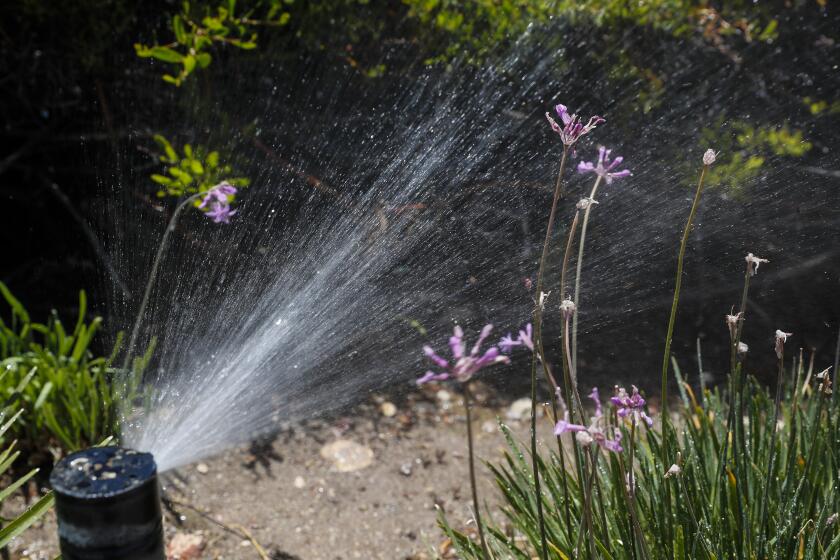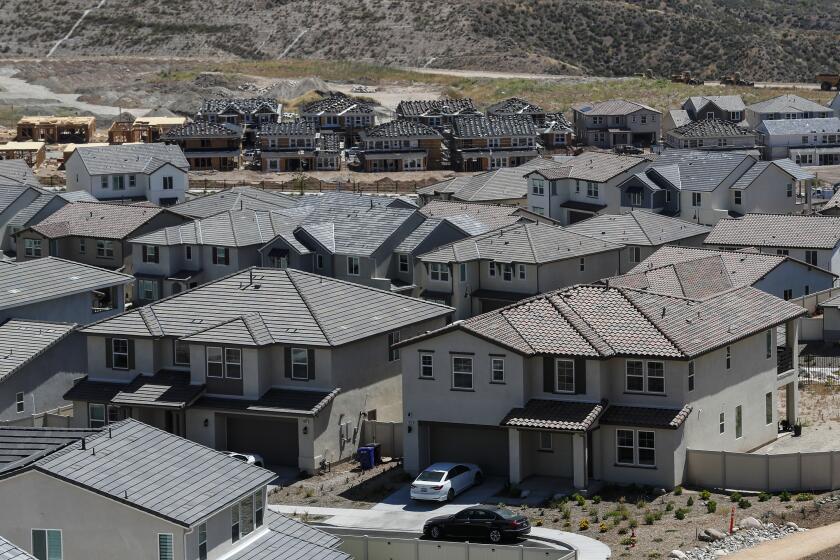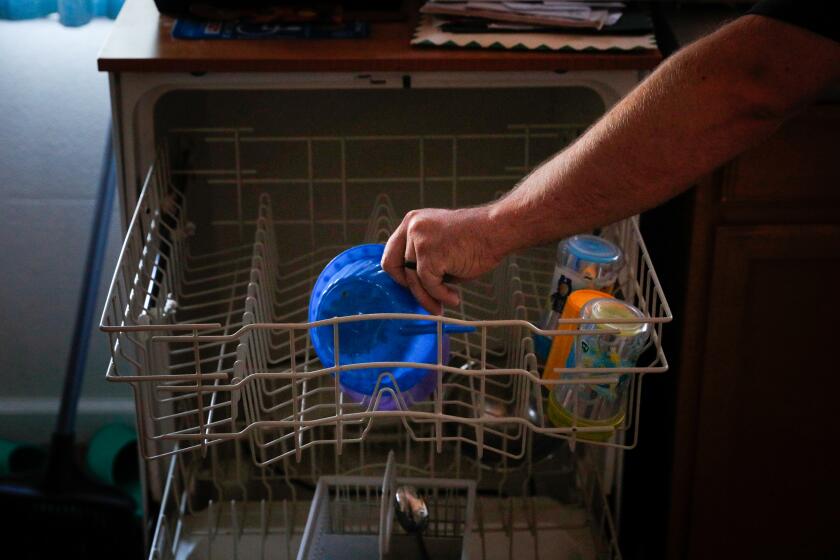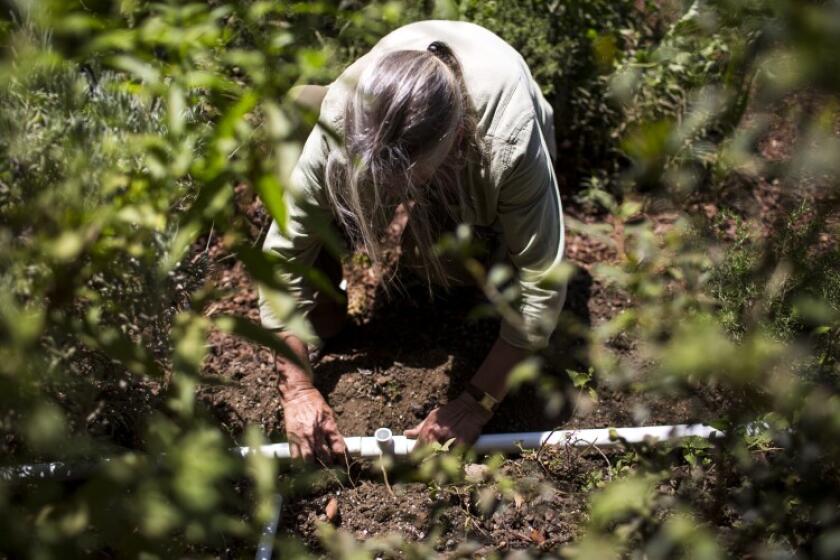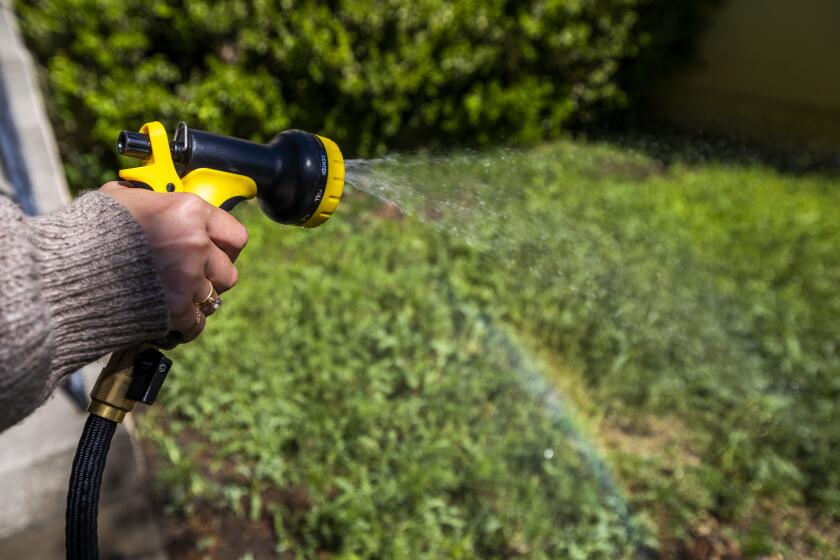Kids can help California save water in the drought. Try making a game out of it

- Share via
Kids love to play with water and in the water, especially on scorching summer days. But experts say you can teach your kids to love saving water too.
California’s latest water emergency is forcing residents to dial back their lawn sprinklers, shorten their showers and make other water-miserly changes in their routines. Although many of the steps we can take as individuals have small payoffs — and nothing we do at home can lower temperatures or bring more rain — every gallon of clean water saved is a gallon that can fill other needs.
And there are a lot of little things kids can do to reduce waste just as easily as their parents can. If you have a teen in your home, chances are you’re familiar with 20-minute showers and three sets of clothes stuffed in the hamper per day. If you have a younger child, there probably are multiple cups half-filled with water scattered around your home at any given moment.
Educators say one good way to change your kids’ water habits is by explaining how their actions affect the community and the environment. That sense of connection will help provide the motivation needed to create water-saving habits.
You can give your kids more incentive, though, by making conservation a game instead of a chore.
Here are some suggestions from experts in child development and “gamification” on how to get your kids to do their part to cut your water bill.
Here are 10 things to consider as the new restrictions — most notably limiting outdoor watering to one or two days a week — set in.
Not nagging, teaching
Many Southern California kids have gotten some training in water conservation at school, through educational programs sponsored by local water agencies. For example, the Los Angeles Department of Water and Power sponsors “Drop in the Bucket,” a science-based water education program by Wildwoods aimed at grades 3-8.
Dwain Wilson, Wildwoods’ founder and executive director, said talking about the gravity of the state’s water shortage is not the way to start the conversation with your kids about cutting water waste. “It’s all about leading with what is the opportunity,” Wilson said. That’s how Wildwoods teaches about climate change, he said — not focusing on the impending crisis, but instead on the things that kids can do to help.
Changing behavior doesn’t come from rote learning, but from having a deep understanding and connection based on personal experience, Wilson said. So parents need to help their kids see how something they care about will benefit from the changes in their routine, whether it’s their environment, their community or the family’s finances.
Tiffany Baca, public affairs manager for the Municipal Water District of Orange County, echoed that point in explaining how her agency’s educational programs have evolved in recent years. “We really needed to start making a connection between water supply and the people who use it,” Baca said.
The point of the agency’s efforts in schools, she said, is to get students to “find water supply sources and start questioning, ‘How did that water get here? Who is affected by the water supply here? What can I do to make things better?’ You become a water advocate simply by exploring the world around you.”
Experts say there’s plenty of water available for new Californians if the trend of residents using less continues and accelerates into the future.
Walking the walk
The messaging in schools can help, but the conservation lessons need to start at home with the example set by parents. “We are our children’s first and most important teachers,” said Mark Moss, principal public affairs representative at the Metropolitan Water District of Southern California. Long before our kids are in preschool, Moss said, “we can model simple water conservation behaviors in front of them.”
It’s also important for parents to offer their kids a quick explanation when they minimize water use — for example, when they turn off the tap while brushing their teeth. It could be as simple as saying, “We’re saving water,” Moss said.
“Kids can absorb age-appropriate water conservation lessons at a very early age,” he added. For preschoolers, the message can be that it’s important to save water today so that we can share it tomorrow with plants, animals and other people. As kids move through elementary school and middle school, Moss said, you can start talking about concepts like the drought and climate change.site:
Kaitzer Puglia, a child development and special education professor at Pasadena City College, said “consistency and perseverance” are key. “Whatever you’re planning to do with children, plan on doing it consistently, across every day,” she said, adding, “It takes a while for habits to form.”
Parents need to be realistic about how much they can shoulder too, and approach the challenge of building new behaviors in small chunks. “Instead of doing six things in one day,” Puglia said, “start with one; do that for two weeks. Then go to the next one, whatever that activity is, for two weeks. Then build on it.”
One other key, she said, is to understand your family’s focus and values, rather than trying to bolt on someone else’s. “The family together has to think, what can they do to contribute? And then really just do that,” Puglia said.
Are you using your dishwasher correctly? Are you using it at all? Everything you wanted to know about washing dishes efficiently during a drought.
Gamification basics
The idea behind gamification is to make a non-game activity deliver the same kinds of psychic and emotional rewards that playing a game can. You’ll need two things to get started: a list of behaviors you want to promote, and the rewards you’ll associate with the different levels of achievement.
“Associating behaviors with recognition can turn them into habits,” advises Centrical, a performance management company. Keeping track of progress toward a goal — say, a target of saving 100 gallons — or charting the number of consecutive days a task is accomplished can reward participants “with a hit of dopamine, and encourage long-term engagement,” wrote Katryna Balboni of the software company Appcues.
You could turn saving water into an intra-family competition, or you could set conservation goals with rewards for meeting them. And you don’t have to come up with all the ideas — you can encourage your kids to design their own water-saving challenges. Implementing their ideas “will inspire them to be more involved in efforts to save water,” the ParentCircle blog says.
“Once kids care about something,” Wilson of Wildwoods said, “the gamification piece is pretty simple.”
He suggested that you start by identifying how your family uses water — bathing, washing clothes, washing dishes, washing cars, watering the lawn, watering the garden, etc. Then, he said, create a way to track what your kids do on each front.
“You can set whatever goals and benchmarks that you want,” he said. “Your water bill will tell you the exact results of your efforts.” In addition to saving water, Wilson said, it’s also “a great lesson in math and data collection.”
The water that cleans your clothes isn’t safe to drink, but it could be good for your plants. Here’s how to use grey water amid drought restrictions.
Some targets for your family
According to the U.S. Environmental Protection Agency, a family of four uses 400 gallons of water a day on average in this country. That leaves a lot of room for improvement.
Typically, families use about as much water outdoors as they do indoors, where the main uses are bathing, washing clothes and washing dishes. So when developing goals and rewards, think about ways to cut down on the amount of bath water, the number of loads of clothes and dishes, and the amount of water sprinkled on your lawn and plants.
Competition can be fun, but it’s not for everyone. To avoid bruised feelings, find ways to spread the winning around.
As Wilson noted, kids do better when they can connect their actions to the benefit produced. So consider putting them in charge of a flower, a specific plant or plants in the garden, then give rewards for watering them with the water they save or recover in the house. (But don’t let the plant die! That would be bad.)
You could track the amount of water saved (for example, by taking shorter showers) and the amount of water found (for example, by reusing the vegetable rinsing water), the number of consecutive days hitting a low-water-use milestone, or the amount the family cuts its monthly water use.
The BBC offers a game you can play periodically, called Leak Detector. Put a teaspoon of food coloring into the tank of one of your toilets. Wait 15 minutes without flushing, then check the water in the bowl for color — if you see some of the tint you put in the tank, then you’ve got a leak that could be squandering as much as 200 gallons a day, the EPA estimated.
L.A. Times readers share how they are conserving water in California amid drought restrictions.
Here are some of the behaviors you might use as targets for your kids (along with the amount of water potentially saved, where estimates are available).
- Turning the water off while brushing your teeth (4 gallons per brush), washing your hands (about 2/3 gallon per washing) and washing the car (up to 100 gallons).
- Rinsing fruits and vegetables in a bowl of water instead of under the faucet.
- Taking a quick shower instead of bathing. Shower heads spray 2 to 2.5 gallons per minute; baths typically take 25 to 35 gallons. So a five-minute shower could use 25 fewer gallons than a bath.
- Not letting bath or shower water go to waste while warming up. That means plugging the bath drain as soon as you start the water running, not after it’s warm. And when showering, collect the gradually warming water in a bucket; you can use the water later to flush the toilet (up to 1.6 gallons per flush for a new toilet, and up to 7 gallons for an old one) or water plants.
- Bathing less often. According to the American Academy of Dermatology Assn., once or twice a week is fine for kids before puberty, as long as they don’t get muddy or sweat-soaked or go swimming. Once puberty hits, daily baths become a thing.
- Hanging up your towel between showers or baths and then using it again. That way, the American Cleaning Institute advises, you can go three to five uses between washes.
- Wearing clothes more often before tossing them in the laundry. According to the American Cleaning Institute, most garments that are not underwear, socks or gym clothes can be reworn at least once or twice between washings unless they are “visibly dirty or stained.”
- Using only one drinking glass per day, and when pouring water, fill the glass only half way at a time. And if there’s anything left over, use it to water the plants rather than pouring it down the drain.
- After scraping off any leftover food, putting dishes directly in the dishwasher without rinsing them.
- Keeping a pitcher of drinking water in the refrigerator instead of running the tap to get cold water.
- At the end of the day, pouring the water left in your pet’s water bowl on the plants instead of into the sink.
- Cleaning the patio or driveway with a broom instead of a hose.
- Washing your bike or scooter with a bucket and sponge instead of a hose.
One factor working in parents’ favor is that their kids may be more receptive to the conservation message than they once were. Puglia, who’s also a member of the La Cañada Unified school board, said the current generation of schoolkids is “really very conscious” of water, climate and planetary issues. She added, “They have a clearer understanding of what’s happening and what the outcome is if we don’t do something.”
About The Times Utility Journalism Team
This article is from The Times’ Utility Journalism Team. Our mission is to be essential to the lives of Southern Californians by publishing information that solves problems, answers questions and helps with decision making. We serve audiences in and around Los Angeles — including current Times subscribers and diverse communities that haven’t historically had their needs met by our coverage.
How can we be useful to you and your community? Email utility (at) latimes.com or one of our journalists: Jon Healey, Ada Tseng, Jessica Roy and Karen Garcia.
More to Read
Sign up for Essential California
The most important California stories and recommendations in your inbox every morning.
You may occasionally receive promotional content from the Los Angeles Times.
